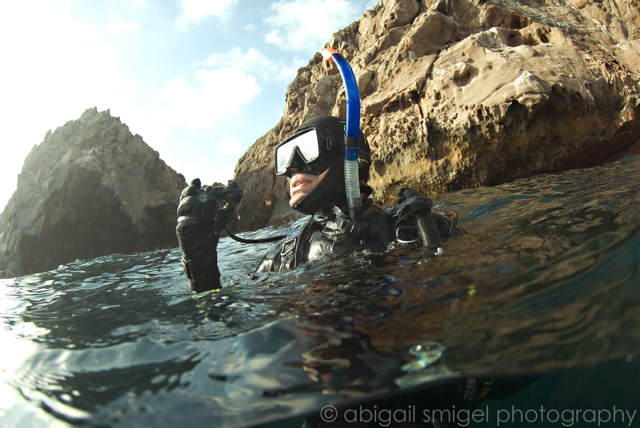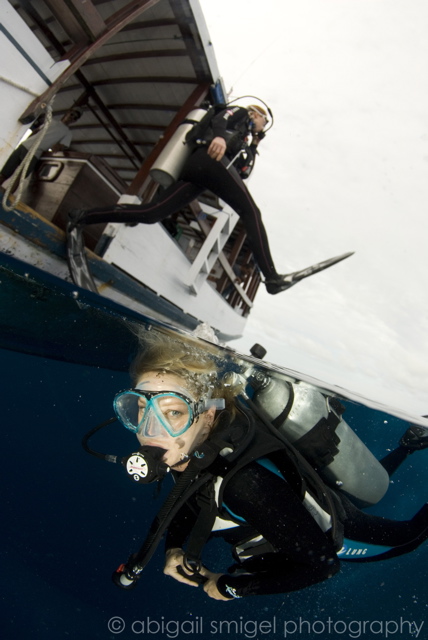You’ve made the commitment . . . you are going to become a scuba diver. Let’s make it clear right now — scuba diving is not an inexpensive hobby. Fortunately, you don’t have to plunge in and purchase everything at once. You can do this in stages to make it affordable. The nice thing about owning your own gear is the ability to grab it and dive whenever you want, with ease. You will likely dive more often. The more you dive, the better you become, and (we suspect) the more you will love it. The best thing about owning your own gear is being intimately familiar with the equipment that sustains your life – knowing how it feels, how it works – so using it becomes second-nature.
There are a few basic things you will need for your open-water class, and for diving in general that are extremely important; they are your mask and snorkel, a pair of fins, and some booties. You will use these each time you dive, and they are worthy of an investment. A mask that fits properly and comfortably is worth every penny. An ill-fitting, leaky mask can suck the enjoyment out of any dive. Don’t let this happen to you. Take the time to go to your local dive shop and let the staff assist you with choosing the mask that is perfect for you. Again, you won’t be sorry. Those of you having problems reading small print can also pick up some stick ‘em bifocals to pop in your mask.

Secondly, your fins. Your fins need to be made for ocean diving. We can’t tell you how many people show up for their first pool session with a cheap pool mask/snorkel/fin set purchased from a local warehouse. It seemed like a good idea at the time. That price tag was screaming out to you as you rolled by with your big shopping cart. You will probably be upset with your instructor when she looks at your fins during the first pool session and tells you to go get “real” fins for the ocean. You will be upset until you wade out into the surf and watch the guy next to you struggle to don his kiddie fins while you slide yours on effortlessly. Then you will smile as you kick your way easily through the surf and see him exhaust himself trying to keep up with everyone else, unless his fins already fell apart, and in that case he will be carrying them back to the beach and packing up to go home. Diving and swimming through even slight currents? Oh yeah! You will be really smiling then. In summary, go to a dive store and find a good pair of fins made for scuba diving. If you are fortunate enough to be open-water certified in the tropics you night opt for full-foot fins, but we hearty cold-water divers need booties that fit into dive fins with straps.
So those are the basics. After that, every instructor and dive-buddy will have a different opinion as to which pieces of scuba gear you should purchase. Your scuba system consists of a Buoyancy Compensation Device (BCD), wetsuit, computer, regulator, tank, and weights. In a perfect world, we could all go and purchase everything at once, and if you can, that’s terrific. If you do not fit into that lucky category, you will need to make some decisions.

We personally would put your BCD purchase very high on the list. Not all BCDs are created equal, and especially for female divers, there are a variety out there specifically cut for a woman’s figure. Styles include wrap-around and back inflate BCDs, weight integrated and not. A lot of this is just personal preference. If you aren’t sure what you like, try renting a couple of different styles and experimenting to find out what works best for you. Having familiarity with the important features on your own BCD will enable you to dial-in to your proficiency with neutral buoyancy more quickly.
A wetsuit that fits you properly is important – it should be snug but comfy. A lycra skin can be purchased to make getting in and out of a wet suit easier, not to mention the hygienic benefits of having your own skin next to your skin when dealing with rental wet-suits (remember it isn’t a question of IF people pee in their wetsuits it’s a question of WHEN!) You should think about the water temperature, where you will be doing most of your diving and choose an appropriate neoprene thickness. Cold water divers may want to consider one with an attached hood or perhaps even a dry-suit.
Computers. There are some amazing dive computers available in a variety of prices. If you are on a budget, just buy a basic computer. Bottom line is you want something to track your nitrogen absorption, time, and depth. Most have the ability to work with enriched air, which is a feature you will likely appreciate at some point. If it’s not air-integrated, you will need to have a submersible pressure gauge (SPG) to monitor your tank pressure. As far as regulators, choose one that you can breathe from easily. You don’t need to break the bank here either.
Remember this is all an iterative a process. So just start diving first. Then enjoy your new mask and fins and get comfortable being in your new world, under the water. Rent some gear and see what you like the best. When you have a few dives under your belt and are ready, make your next purchase, knowing your choices are being guided by YOUR own informed-experience.
Have gear, will dive.
